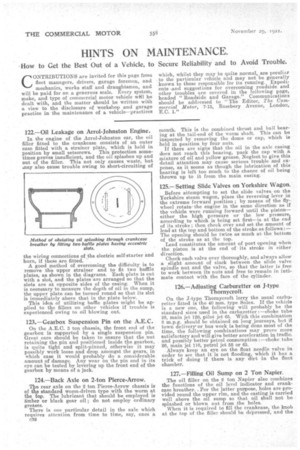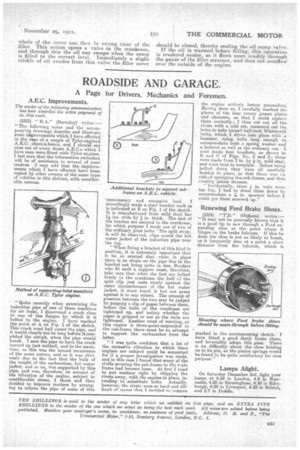122.—Oil Leakage on Arrol-Johnston Engine.
Page 30

Page 31

If you've noticed an error in this article please click here to report it so we can fix it.
In the engine of the ArroleTohnston ear, the oil filler fitted to the crankcase consists of an outer case fitted with a strainer plate, which is held in position by small setscrews. This protection sometimes proves insufficient, and the oil splashes up and out of the filler. This not only causes waste, but may also cause trouble owing to short-circuiting of the wiring connections of the electric self-starter and horn, if these are fitted.
A good method of overcoming the difficulty is to remove the upper strainer and to fit two baffile plates, as shown in the diagrams. Each plate is cut with a slot, and the plates arc arranged so that the slots are at opposite sides of the casing. When it is necessary to measure the depth of oil in the sump, the upper plate can be turned round so that its slot is immediately above that in the plate below. This idea. of utilizing baffle plates might be applied to the fillers on other vehicles if trouble is experienced owing to oil blowing out.
123.—Gearbox Suspension Pin on the A.E.C.
On the A.E.C. 3 ton chassis, the front end of the gearbox is supported by a single suspension pin. Great care should be taken to ensure that the nut retaining the pin and positioned inside the gearbox, is quite tight and split-pinned, otherwise it may possibly work loose and drop amongst the gears, in which case it would probably do a considerable amount of damage. Any wear on the pin and in its eye can be tested by levering up the front end of the gearbox by means of a jack.
124.—Back Axle on 2-ton Pierce-Arrow.
e rear axle on the 2 ton Pierce-Arrow chassis is of tke standard worm-driven type with the worm at the tcp. The lubricant that should be employed is limber or black gear oil; do not employ ordinary greases.
There is one particular detail in the axle which requires attention from time to time, say, once a 032 month. This is the combined thrust and ball bearing at the tail-end of the worm shaft. This can be inspected by removing the dome or cap, which is held in position by four nuts. If there are signs that the oil in the axle casing does not reach this bearing, pack the cap with a mixture of oil and yellow grease. Neglect to give this detail attention may cause serious trouble and expense, as it seems as though the lubrication of this bearing is left too much to the chance of oil being thrown up to it from the main casing.
125.— Setting Slide Valves on Yorkshire Wagon.
Before attempting to set the slide valves on the Yorkshire steam wagon, place the reversing lever in the extreme forward position • by means of the flywheel rotate. the engine in the same direction as if the vehicle were running forward until the piston— either the high pressure or the low pressure, according to which is being set first—is at the end of its stroke ; then check over and set the amount of lead at the top and bottom of the stroke as follows:— The opening should be twice as much at the bottom of the stroke as at the top. Lead constitutes the amount of port opening when the piston is at the end of its stroke in either direction.
Check each valve over thoroughly, and always allow a slight amount of slack between the slide valve spindle nut and the valve, so that the latter is free to work between Its nuts and free to remain in intimate contact with the face of the cylinder.
126.—Adjusting Carburetter on J-type Thornycroft.
On the J-type Thornycroft lorry the usual carbue setter fitted is the 40 mm. type Solex. If the vehicle is a new one, the following will probably be the standard sizes used in the carburetter :—choke tube 28, main jet 120, pilot jet 65. 'With this combination 8 m.p.g. should be obtained on long journeys, but if town delivery or bus work is being done most of the time, the following combinations may prove more satisfactory and will give better acceleration in traffic. and possibly better petrol consumption :—choke tube 26, main jet 110, petrol jet 55 or 65.
Always keep an eye on the float needle valve in order to see that it is not flooding, which it has a trick of doing if there is any dirt in the float chamber.
127.—Filling Oil Sump on 2 Ton Napier.
The oil filler on the 2 ton Napier also combines the functions of the oil level indicator and crankcase breather. For the latter purpose, holes are provided round the upper rim, and the casting is carried well above the oil sump so that oil shall not be splashed or blown out from the holes. When it is required to fill the crankcase, the knob at the top of the filler should be dePressed, and the whole of the cover can _then be swung clear of the filler. This action opens a valve in the crankcase, and through this the oil can escape when the sump is filled to the correct level. Immediately a slight trickle of oil exudes from this valve the filler cover should be closed, thereby sealing the oil sump valve.
If the oil is warmed before filling, this -.operation is rendered easier, as it flows more readily through the gauze of the filler strainer, and does not overflow over the outside of the engine.
































